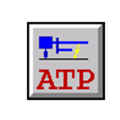

Grid Protection - Protection Functions and Protection Analysis
Main protection devices and main protection functions are simulated in ATPDesigner by generic, i.e. manufacturer-independent models. This makes it possible to apply the results obtained with ATPDesigner to existing mains protection concepts, regardless of the technical product characteristics. The generic models of the mains protection devices also ensure simple and backwards-compatible expandability of the mains protection concepts and the application also for future tasks in mains protection technology.
Main Protection Functions
Additional Protection Functions
Main Protection Functions
- Overcurrent protection
- Overcurrent protection with short-circuit direction
- Distance protection with U/I excitation and polygonal or circular characteristic with 8 distance zones
- Differential protection for 2 or 3 current measurements
- Fuses (NH and HH fuses)
- Low-voltage circuit-breaker
- Protective signaling
- Over- and undervoltage protection
- Underimpedance detection
- IDMT protection
Additional Protection Functions
- Protection logic e.g. for signal comparison
- Wattmetric earth fault location
- Underimpedance detection
- Automatic Reclosing
Tasks of Protection Relays
The task of grid protection is to continuously monitor the physical grid state, to detect impermissible grid states and to return the power grid to a permissible operating state within a reasonable time. Short-circuits are one of the most critical impermissible network states, as the very large short-circuit currents occurring in the event of a short-circuit can endanger people and cause impermissible mechanical and thermal loads on the equipment. The basic principle of mains protection is selective protection. Faults as the cause of impermissible network states are detected selectively by fault location and type and the equipment causing or affected by the fault is disconnected from the mains supply at all poles and on all sides. In the event of a short-circuit, this process is generally referred to as short-circuit tripping or tripping for short. After tripping, the power supply system is back in normal operation without faults and is available for the supply task.
